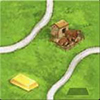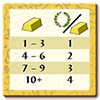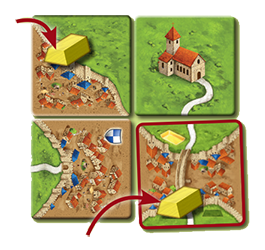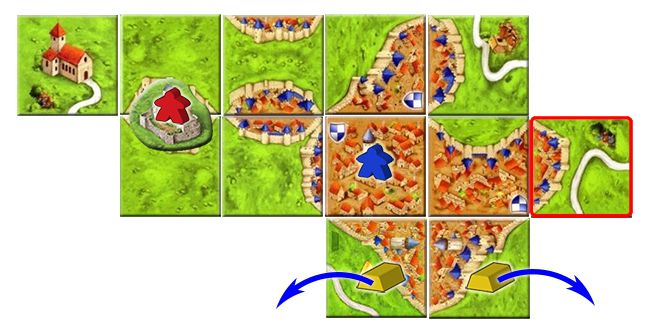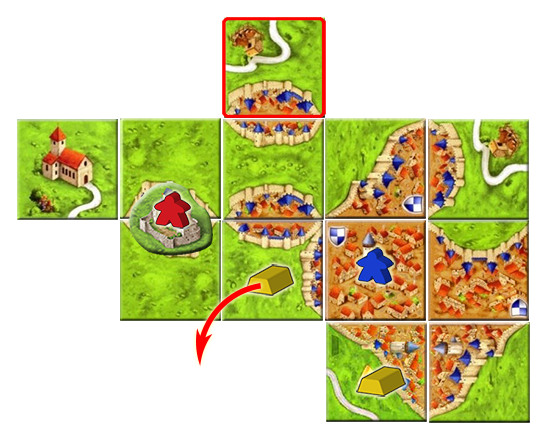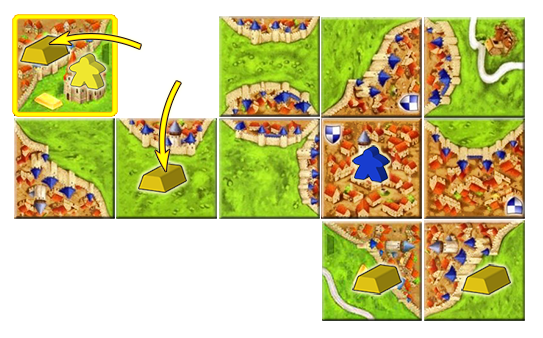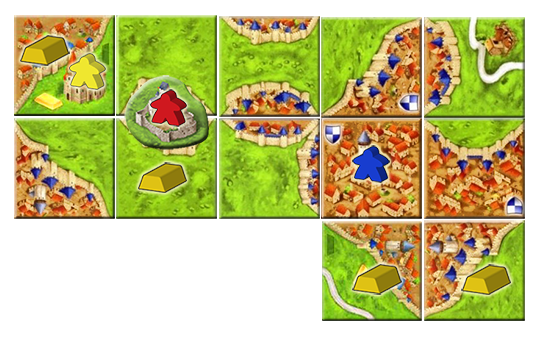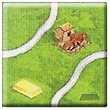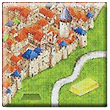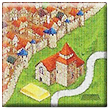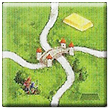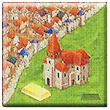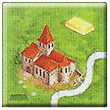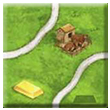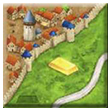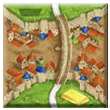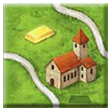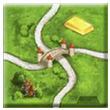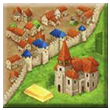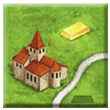The Goldmines
 |
You are reading the rules for this tile design. |  |
 | Read the following rules if your tiles look like this. |
| If your tiles have a different design, then choose a game from Spin-offs. |  |
Gold is scattered throughout the realm, sought by everyone. The value of each ingot, however, remains unknown until the end of the game.
General info and comments
 Expansion symbol |
Goldmines (Mini #4) was released by HiG for the second edition, known as C2 for short, in 2017, bundled as part of ![]() Big Box 6. A third edition, known as C3 for short, was released in 2021 including more detailed graphics, cities with clipped buildings and some minor wording changes. The C3 version of this expansion is only available as part of
Big Box 6. A third edition, known as C3 for short, was released in 2021 including more detailed graphics, cities with clipped buildings and some minor wording changes. The C3 version of this expansion is only available as part of ![]() Big Box 7.
Big Box 7.
This expansion was originally released for the first edition, known as C1 for short, in 2012.
Contents
- 8 landscape tiles with gold logo
- 1 scoring token
- 16 wooden gold ingots
Rules
Preparation
Shuffle the new landscape tiles with those of the basic game and stack them normally. Place the ingots within easy reach of all players.
Gameplay
1. Placing a tile
When you draw a tile with gold on it, place it normally. Then, place one gold ingot on it, and one gold ingot on an adjacent tile of your choice (diagonal is allowed). So you always place two gold ingots per tile with the gold symbol. You may also place a gold ingot on a tile that already has one or more gold ingots from a previous turn. Gold ingots are not assigned to specific features. They always apply to all the features on a tile (see 3. Scoring a feature).
2. Placing a meeple
After gold placement, you may still place a meeple according to the normal rules.
3. Scoring a feature
When you complete a feature with one or more gold ingots on its tiles, those gold ingots are awarded. The player with the majority in the completed feature takes all the gold from the corresponding tiles. For roads and cities, every tile that is part of that road or city is included; in the case of monasteries, the monastery and each of its 8 surrounding tiles are all included. [1] [2] [3]
In case of a tie: If multiple players share the majority in a completed feature with gold ingots on one or more of its tiles, or if several features with gold ingots are completed at the same time and they are controlled by different players, the distribution is as follows: Starting from the active player, all players take one gold ingot to which they are entitled in clockwise order. This continues until all the gold ingots involved have been taken. [4] [5]
Players will place their gold ingots before them for the remainder of the game. The gold ingots will be scored during the final scoring. [6]
Final Scoring
After the game ends but before final scoring, set aside all the gold ingots that are still on tiles (the ones that have not yet been collected by a player). Farmers receive no gold pieces.
After the final scoring, players scores the gold ingots they collected. The more gold ingots you collected, the more each gold ingot is worth to you. Count your collected gold ingots, and compare your final count to the values listed in the table below to determine how many points each of your gold ingots is worth. The table is also provided on scoring tile for display.
Sequence Summary
When playing with The Gold Mines, the turn sequence is as follows:
- 1. Place a Tile
- 2. Place Two Gold Ingots
- 3. Place a Meeple
- 4. Score a Feature
- 5. Take Gold
Other Expansions
If playing with other expansions, please take the following notes into consideration:
![]() Exp. 8 - Bridges, Castles & Bazaars
Exp. 8 - Bridges, Castles & Bazaars
![]() A castle lord can collect gold ingots placed in its castle fief. It does not matter if the gold ingots are not located on tiles occupied by the feature triggering the castle scoring.
A castle lord can collect gold ingots placed in its castle fief. It does not matter if the gold ingots are not located on tiles occupied by the feature triggering the castle scoring.
![]() Question: Can a castle receive collect gold ingots placed in its fief the same as monastery collects gold ingots placed on the monastery tile or any adjacent tile?
Question: Can a castle receive collect gold ingots placed in its fief the same as monastery collects gold ingots placed on the monastery tile or any adjacent tile?
Answer: A castle can also take gold ingots, those located in the castle fief. The castle fief has 6 tiles: the two on which the castle was built, the two to the right and the two to the left of it. The castle lord can take gold ingots from them.
If there are several players entitled to gold ingots, the gold is distributed one by one, as described in the rules. (6/2013)
- The following examples illustrate how gold ingots are distributed in some scenarios involving castles: [7]
- When scoring a castle, its owner can only collect gold ingots placed in the castle fief. Any gold ingots on tiles outside the castle fief will not be eligible even if they belong to the feature triggering the castle scoring.
- Players take turns when taking eligible gold ingots placed on the tiles of the features being scoring. Depending on the sequence followed, some players with eligible gold ingots may end up taking none.
- Example 1: Exploring various sequences
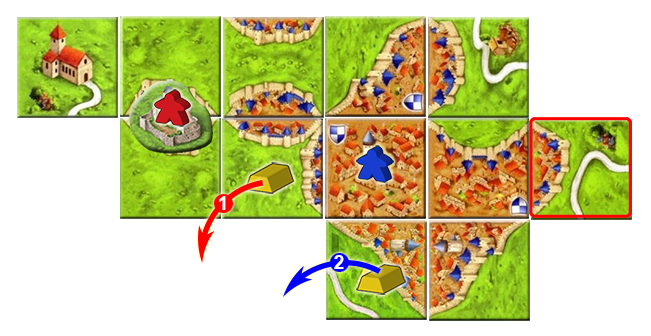 Example 1A: Red completes the city occupied by Blue, which triggers the scoring of the castle occupied by Red. As the active player, Red takes a gold ingot first, and then Blue. Blue was also entitled to the gold ingot taken by Red (placed in the castle fief and also on one tile of the city controlled by Blue), but it was Red's only choice in this case. Therefore, Blue can only take the gold ingot at the bottom of the city.
Example 1A: Red completes the city occupied by Blue, which triggers the scoring of the castle occupied by Red. As the active player, Red takes a gold ingot first, and then Blue. Blue was also entitled to the gold ingot taken by Red (placed in the castle fief and also on one tile of the city controlled by Blue), but it was Red's only choice in this case. Therefore, Blue can only take the gold ingot at the bottom of the city.
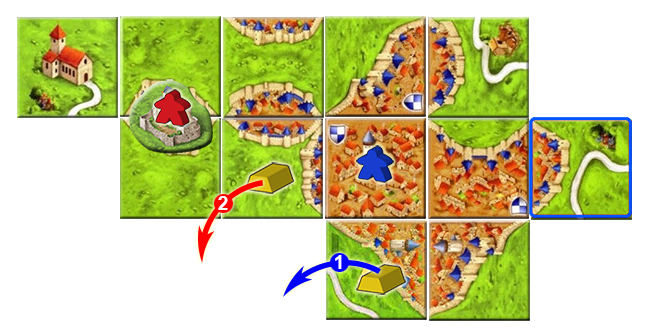 Example 1B-1: Blue completes their city, which triggers the scoring of the castle occupied by Red. As the active player, Blue takes a gold ingot first and then Red. Blue was also entitled to the gold ingot taken by Red (placed in the castle fief and also on one tile of the city controlled by Blue), and it was Red's only choice in this case, since Blue took the gold ingot at the bottom of the city.
Example 1B-1: Blue completes their city, which triggers the scoring of the castle occupied by Red. As the active player, Blue takes a gold ingot first and then Red. Blue was also entitled to the gold ingot taken by Red (placed in the castle fief and also on one tile of the city controlled by Blue), and it was Red's only choice in this case, since Blue took the gold ingot at the bottom of the city.
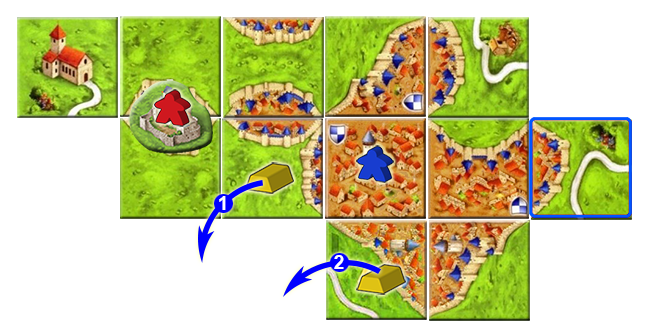 Example 1B-2: Blue completes their city, which triggers the scoring of the castle occupied by Red. As the active player, Blue manages to take both gold ingots. Blue takes the gold ingot in the castle fief first (both Red and Blue were entitled to take it), so Red cannot take any gold ingots. Finally, Blue takes the gold ingot at the bottom of the city.
Example 1B-2: Blue completes their city, which triggers the scoring of the castle occupied by Red. As the active player, Blue manages to take both gold ingots. Blue takes the gold ingot in the castle fief first (both Red and Blue were entitled to take it), so Red cannot take any gold ingots. Finally, Blue takes the gold ingot at the bottom of the city.
- Example 2: Exploring best outcome
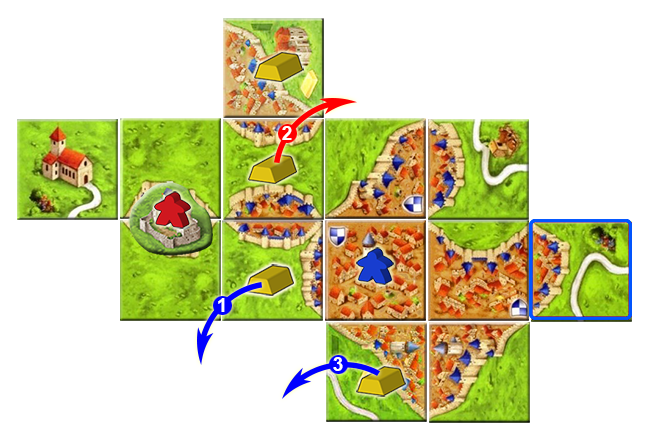 Example 2A: Blue completes their city, which triggers the scoring of the castle occupied by Red. There are two gold ingots in the castle fief, one of them placed on a tile of the city controlled by Blue). As the active player, Blue decides to take the gold ingot in the castle fief which Red is also entitled to, so Red is forced to take the other gold ingot in the fief. Finally, Blue takes the gold ingot at the bottom of the city.
Example 2A: Blue completes their city, which triggers the scoring of the castle occupied by Red. There are two gold ingots in the castle fief, one of them placed on a tile of the city controlled by Blue). As the active player, Blue decides to take the gold ingot in the castle fief which Red is also entitled to, so Red is forced to take the other gold ingot in the fief. Finally, Blue takes the gold ingot at the bottom of the city.
Blue gets 2 gold ingots and Red gets one gold ingot.
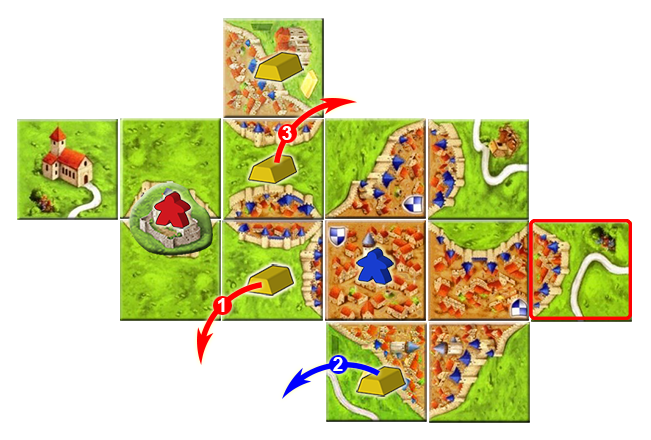 Example 2B: Red completes the city occupied by Blue, which triggers the scoring of the castle occupied by Red. There are two gold ingots in the castle fief, one of them placed on a tile of the city controlled by Blue). As the active player, Red decides to take the gold ingot in the castle fief which Blue is also entitled to, so Blue is forced to take the gold ingot at the bottom of the city. Finally, Red takes the other gold ingot in the fief.
Example 2B: Red completes the city occupied by Blue, which triggers the scoring of the castle occupied by Red. There are two gold ingots in the castle fief, one of them placed on a tile of the city controlled by Blue). As the active player, Red decides to take the gold ingot in the castle fief which Blue is also entitled to, so Blue is forced to take the gold ingot at the bottom of the city. Finally, Red takes the other gold ingot in the fief.
Blue gets 1 gold ingot and Red gets 2 gold ingots.
- Example 3: Triggering the gold ingot distribution but collecting none
- When scoring a castle, its owner is only entitled to those gold ingots placed in the castle fief, even if they are not on tiles belonging to the feature triggering the castle scoring.
- Example 4: Features triggering the scoring are irrelevant
- Example 5: Sequence involving the building of a castle
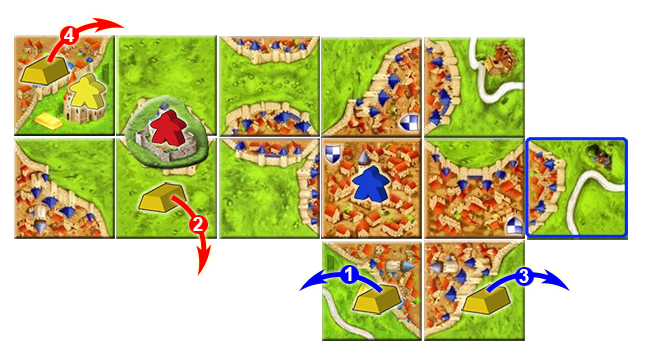 Example 5.4: Blue completes their city, triggering the scoring of the castle occupied by Red. Blue and Red will take gold ingots in turns. Blue will take the two ingots at the bottom of the city and Red will take the two gold ingots in the castle fief, no matter the gold ingots are not on the feature triggering the castle scoring.
Example 5.4: Blue completes their city, triggering the scoring of the castle occupied by Red. Blue and Red will take gold ingots in turns. Blue will take the two ingots at the bottom of the city and Red will take the two gold ingots in the castle fief, no matter the gold ingots are not on the feature triggering the castle scoring.
- When monastery in a castle fief is scored, its owner can take any gold ingots placed on its neighborhood. The neighboring castle, can only consider those gold ingots in its castle fief.
- Example 6: Exploring the scoring of a monastery overlapping a castle fief
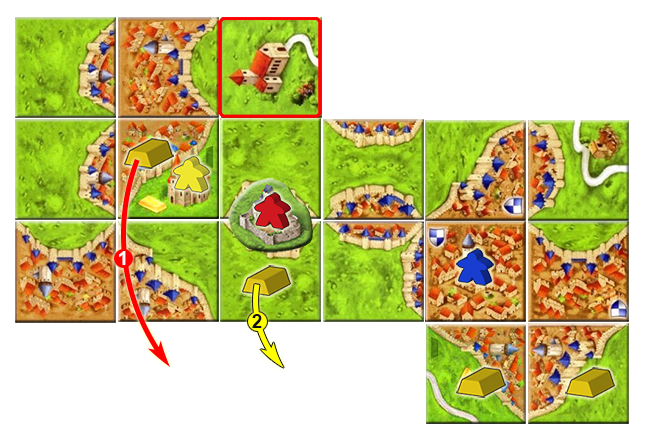 Example 6-1: Red completes the monastery occupied by Yellow, triggering the scoring of the castle occupied by Red. Red and Yellow will take one gold ingot each, no matter the order they are chosen, since the two gold ingots are both in the castle fief and in the vicinity of the monastery (i.e. on the monastery tile or any adjacent tile).
Example 6-1: Red completes the monastery occupied by Yellow, triggering the scoring of the castle occupied by Red. Red and Yellow will take one gold ingot each, no matter the order they are chosen, since the two gold ingots are both in the castle fief and in the vicinity of the monastery (i.e. on the monastery tile or any adjacent tile).
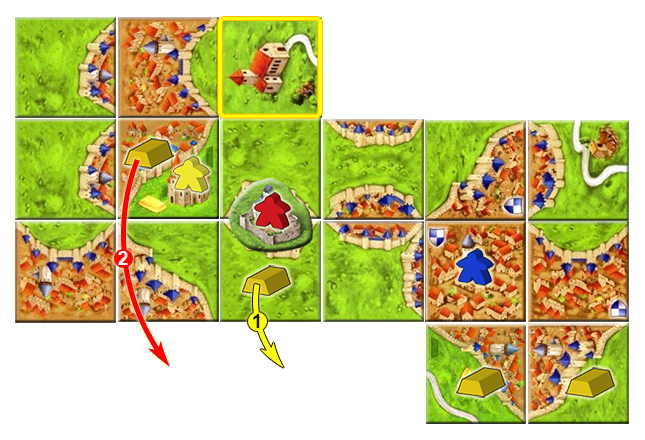 Example 6-2: Yellow completes their monastery, triggering the scoring of the castle occupied by Red. Yellow and Red will take one gold ingot each, no matter the order they are chosen, since the two gold ingots are both in the castle fief and in the vicinity of the monastery (i.e. on the monastery tile or any adjacent tile).
Example 6-2: Yellow completes their monastery, triggering the scoring of the castle occupied by Red. Yellow and Red will take one gold ingot each, no matter the order they are chosen, since the two gold ingots are both in the castle fief and in the vicinity of the monastery (i.e. on the monastery tile or any adjacent tile).
Tile Distribution
C3 Edition
C2 Edition
Footnotes
For Icons explanation and licensing please visit Icons page.
- ↑
 When a castle is completed, the owner can lay claim to gold ingots in the 6-tile vicinity of the castle: the 2 tiles upon which the castle is built, the 2 tiles to its left, and the 2 tiles to its right. The owner of the castle does not necessarily have the rights to gold associated with the feature that caused completion of the castle (unless that gold ingot is also within the castle's vicinity or the castle owner
also has a majority in the primary feature). (6/2013)
When a castle is completed, the owner can lay claim to gold ingots in the 6-tile vicinity of the castle: the 2 tiles upon which the castle is built, the 2 tiles to its left, and the 2 tiles to its right. The owner of the castle does not necessarily have the rights to gold associated with the feature that caused completion of the castle (unless that gold ingot is also within the castle's vicinity or the castle owner
also has a majority in the primary feature). (6/2013)
- ↑
 In general, any gold ingots on tiles of a completed feature will be distributed while the feature is being scored. Depending on the feature, the gold ingots involved may differ:
In general, any gold ingots on tiles of a completed feature will be distributed while the feature is being scored. Depending on the feature, the gold ingots involved may differ:
- Features distributing gold ingots on their tiles only:
- Roads
- Cities
- Features distributing gold ingots on the feature tile and its adjacent tiles:
- Monastic buildings: monasteries, abbeys, shrines, German monasteries (with a monk), Dutch & Belgian monasteries (with a monk), Japanese buildings (with a monk), Darmstadt churches
- Gardens
- Baba Yaga's hut
- German castles
- Cemeteries
- Haunted castles
- Features distributing gold ingots on the feature tile and the road tiles connected to it:
- German cathedrals
- Features distributing gold ingots on the tiles adjacent to the feature:
- Castles
- Features distributing gold ingots on their tiles only:
- ↑
 As a consequence of the rules, gold ingots on the tiles of a completed unclaimed feature will not be distributed, since there is no player controlling the feature.
As a consequence of the rules, gold ingots on the tiles of a completed unclaimed feature will not be distributed, since there is no player controlling the feature.
- ↑
 In general, if one or more features are involved, the active player (if entitled to gold) chooses the first gold ingot and can choose any one of the ingots to which he/she may be entitled. The next player (in clockwise order) that is entitled to a gold ingot can then choose an appropriate ingot. Note that, because a player can choose which ingot to take first (if there is more than one to choose from), a different player who may have initially been entitled to a gold ingot may miss out if that ingot has been claimed before it is that player's turn to choose. (6/2013)
In general, if one or more features are involved, the active player (if entitled to gold) chooses the first gold ingot and can choose any one of the ingots to which he/she may be entitled. The next player (in clockwise order) that is entitled to a gold ingot can then choose an appropriate ingot. Note that, because a player can choose which ingot to take first (if there is more than one to choose from), a different player who may have initially been entitled to a gold ingot may miss out if that ingot has been claimed before it is that player's turn to choose. (6/2013)
- ↑
 This paragraph has been reworded to include the case about features controlled by different players that are completed at the same time. Although provided by HiG, this case was omitted by ZMG and the wording only covered the case where multiple players share the majority in one feature.
This paragraph has been reworded to include the case about features controlled by different players that are completed at the same time. Although provided by HiG, this case was omitted by ZMG and the wording only covered the case where multiple players share the majority in one feature.
- ↑
 These two sentences provided by HiG were omitted by ZMG.
These two sentences provided by HiG were omitted by ZMG.
- ↑
 These examples are based on the clarifications provided by Kettlefish on the following threads, according to the clarification provided by Christof Tisch from 6/2013.
These examples are based on the clarifications provided by Kettlefish on the following threads, according to the clarification provided by Christof Tisch from 6/2013.
- Carcassonne Central: https://www.carcassonnecentral.com/community/index.php?topic=279.0
- Carcassonne Forum: https://www.carcassonne-forum.de/viewtopic.php?f=101&t=886
